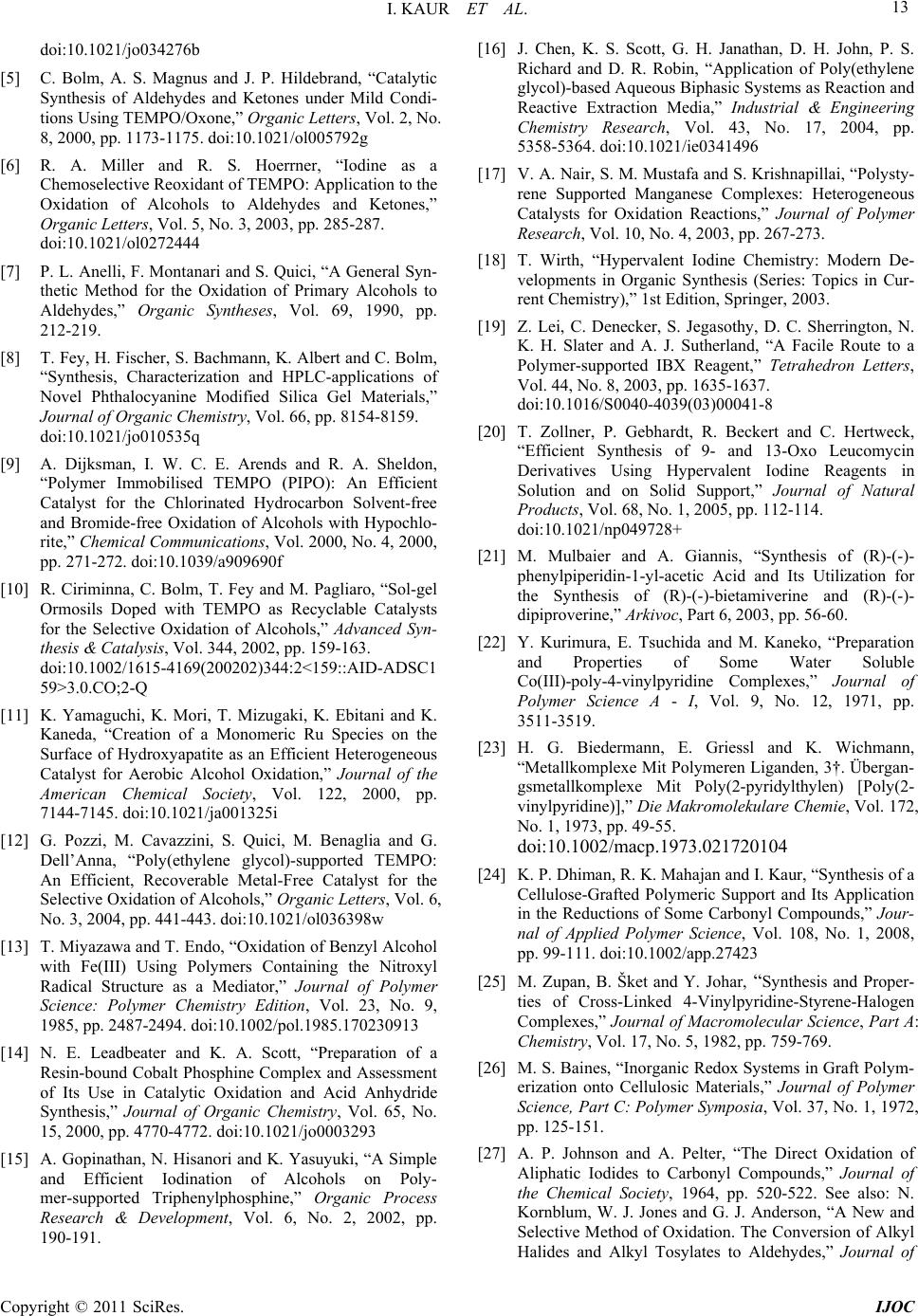
I. KAUR ET AL. 13
doi:10.1021/jo034276b
[5] C. Bolm, A. S. Magnus and J. P. Hildebrand, “Catalytic
Synthesis of Aldehydes and Ketones under Mild Condi-
tions Using TEMPO/Oxone,” Organic Letters, Vol. 2, No.
8, 2000, pp. 1173-1175. doi:10.1021/ol005792g
[6] R. A. Miller and R. S. Hoerrner, “Iodine as a
Chemoselective Reoxidant of TEMPO: Application to the
Oxidation of Alcohols to Aldehydes and Ketones,”
Organic Letters, Vol. 5, No. 3, 2003, pp. 285-287.
doi:10.1021/ol0272444
[7] P. L. Anelli, F. Montanari and S. Quici, “A General Syn-
thetic Method for the Oxidation of Primary Alcohols to
Aldehydes,” Organic Syntheses, Vol. 69, 1990, pp.
212-219.
[8] T. Fey, H. Fischer, S. Bachmann, K. Albert and C. Bolm,
“Synthesis, Characterization and HPLC-applications of
Novel Phthalocyanine Modified Silica Gel Materials,”
Journal of Organic Chemistry, Vol. 66, pp. 8154-8159.
doi:10.1021/jo010535q
[9] A. Dijksman, I. W. C. E. Arends and R. A. Sheldon,
“Polymer Immobilised TEMPO (PIPO): An Efficient
Catalyst for the Chlorinated Hydrocarbon Solvent-free
and Bromide-free Oxidation of Alcohols with Hypochlo-
rite,” Chemical Communications, Vol. 2000, No. 4, 2000,
pp. 271-272. doi:10.1039/a909690f
[10] R. Ciriminna, C. Bolm, T. Fey and M. Pagliaro, “Sol-gel
Ormosils Doped with TEMPO as Recyclable Catalysts
for the Selective Oxidation of Alcohols,” Advanced Syn-
thesis & Catalysis, Vol. 344, 2002, pp. 159-163.
doi:10.1002/1615-4169(200202)344:2<159::AID-ADSC1
59>3.0.CO;2-Q
[11] K. Yamaguchi, K. Mori, T. Mizugaki, K. Ebitani and K.
Kaneda, “Creation of a Monomeric Ru Species on the
Surface of Hydroxyapatite as an Efficient Heterogeneous
Catalyst for Aerobic Alcohol Oxidation,” Journal of the
American Chemical Society, Vol. 122, 2000, pp.
7144-7145. doi:10.1021/ja001325i
[12] G
. Pozzi, M. Cavazzini, S. Quici, M. Benaglia and G.
Dell’Anna, “Poly(ethylene glycol)-supported TEMPO:
An Efficient, Recoverable Metal-Free Catalyst for the
Selective Oxidation of Alcohols,” Organic Letters, Vol. 6,
No. 3, 2004, pp. 441-443. doi:10.1021/ol036398w
[13] T. Miyazawa and T. Endo, “Oxidation of Benzyl Alcohol
with Fe(III) Using Polymers Containing the Nitroxyl
Radical Structure as a Mediator,” Journal of Polymer
Science: Polymer Chemistry Edition, Vol. 23, No. 9,
1985, pp. 2487-2494. doi:10.1002/pol.1985.170230913
[14] N. E. Leadbeater and K. A. Scott, “Preparation of a
Resin-bound Cobalt Phosphine Complex and Assessment
of Its Use in Catalytic Oxidation and Acid Anhydride
Synthesis,” Journal of Organic Chemistry, Vol. 65, No.
15, 2000, pp. 4770-4772. doi:10.1021/jo0003293
[15] A. Gopinathan, N. Hisanori and K. Yasuyuki, “A Simple
and Efficient Iodination of Alcohols on Poly-
mer-supported Triphenylphosphine,” Organic Process
Research & Development, Vol. 6, No. 2, 2002, pp.
190-191.
[16] J. Chen, K. S. Scott, G. H. Janathan, D. H. John, P. S.
Richard and D. R. Robin, “Application of Poly(ethylene
glycol)-based Aqueous Biphasic Systems as Reaction and
Reactive Extraction Media,” Industrial & Engineering
Chemistry Research, Vol. 43, No. 17, 2004, pp.
5358-5364. doi:10.1021/ie0341496
[17] V. A. Nair, S. M. Mustafa and S. Krishnapillai, “Polysty-
rene Supported Manganese Complexes: Heterogeneous
Catalysts for Oxidation Reactions,” Journal of Polymer
Research, Vol. 10, No. 4, 2003, pp. 267-273.
[18] T. Wirth, “Hypervalent Iodine Chemistry: Modern De-
velopments in Organic Synthesis (Series: Topics in Cur-
rent Chemistry),” 1st Edition, Springer, 2003.
[19] Z. Lei, C. Denecker, S. Jegasothy, D. C. Sherrington, N.
K. H. Slater and A. J. Sutherland, “A Facile Route to a
Polymer-supported IBX Reagent,” Tetrahedron Letters,
Vol. 44, No. 8, 2003, pp. 1635-1637.
doi:10.1016/S0040-4039(03)00041-8
[20] T. Zollner, P. Gebhardt, R. Beckert and C. Hertweck,
“Efficient Synthesis of 9- and 13-Oxo Leucomycin
Derivatives Using Hypervalent Iodine Reagents in
Solution and on Solid Support,” Journal of Natural
Products, Vol. 68, No. 1, 2005, pp. 112-114.
doi:10.1021/np049728+
[21] M. Mulbaier and A. Giannis, “Synthesis of (R)-(-)-
phenylpiperidin-1-yl-acetic Acid and Its Utilization for
the Synthesis of (R)-(-)-bietamiverine and (R)-(-)-
dipiproverine,” Arkivoc, Part 6, 2003, pp. 56-60.
[22] Y. Kurimura, E. Tsuchida and M. Kaneko, “Preparation
and Properties of Some Water Soluble
Co(III)-poly-4-vinylpyridine Complexes,” Journal of
Polymer Science A - I, Vol. 9, No. 12, 1971, pp.
3511-3519.
[23] H. G. Biedermann, E. Griessl and K. Wichmann,
“Metallkomplexe Mit Polymeren Liganden, 3†. Übergan-
gsmetallkomplexe Mit Poly(2-pyridylthylen) [Poly(2-
vinylpyridine)],” Die Makromolekulare Chemie, Vol. 172,
No. 1, 1973, pp. 49-55.
doi:10.1002 /macp.1973 .021720104
[24] K. P. Dhiman, R. K. Mahajan and I. Kaur, “Synthesis of a
Cellulose-Grafted Polymeric Support and Its Application
in the Reductions of Some Carbonyl Compounds,” Jour-
nal of Applied Polymer Science, Vol. 108, No. 1, 2008,
pp. 99-111. doi:10.1002/app.27423
[25] M. Zupan, B. Šket and Y. Johar, “Synthesis and Proper-
ties of Cross-Linked 4-Vinylpyridine-Styrene-Halogen
Complexes,” Journal of Macromolecular Science, Part A:
Chemistry, Vol. 17, No. 5, 1982, pp. 759-769.
[26] M. S. Baines, “Inorganic Redox Systems in Graft Polym-
erization onto Cellulosic Materials,” Journal of Polymer
Science, Part C: Polymer Symposia, Vol. 37, No. 1, 1972,
pp. 125-151.
[27] A. P. Johnson and A. Pelter, “The Direct Oxidation of
Aliphatic Iodides to Carbonyl Compounds,” Journal of
the Chemical Society, 1964, pp. 520-522. See also: N.
Kornblum, W. J. Jones and G. J. Anderson, “A New and
Selective Method of Oxidation. The Conversion of Alkyl
Halides and Alkyl Tosylates to Aldehydes,” Journal of
C
opyright © 2011 SciRes. IJOC